AT7519, A novel small molecule multi-cyclin-dependent kinase inhibitor, induces apoptosis in multiple myeloma via GSK-3beta activation and RNA polymerase II inhibition
- PMID: 20101221
- PMCID: PMC3183744
- DOI: 10.1038/onc.2009.510
AT7519, A novel small molecule multi-cyclin-dependent kinase inhibitor, induces apoptosis in multiple myeloma via GSK-3beta activation and RNA polymerase II inhibition
Abstract
Dysregulated cell cycling is a universal hallmark of cancer and is often mediated by abnormal activation of cyclin-dependent kinases (CDKs) and their cyclin partners. Overexpression of individual complexes are reported in multiple myeloma (MM), making them attractive therapeutic targets. In this study, we investigate the preclinical activity of a novel small-molecule multi-CDK inhibitor, AT7519, in MM. We show the anti-MM activity of AT7519 displaying potent cytotoxicity and apoptosis; associated with in vivo tumor growth inhibition and prolonged survival. At the molecular level, AT7519 inhibited RNA polymerase II (RNA pol II) phosphorylation, a CDK9, 7 substrate, associated with decreased RNA synthesis confirmed by [(3)H] Uridine incorporation. In addition, AT7519 inhibited glycogen synthase kinase 3beta (GSK-3beta) phosphorylation; conversely pretreatment with a selective GSK-3 inhibitor and shRNA GSK-3beta knockdown restored MM survival, suggesting the involvement of GSK-3beta in AT7519-induced apoptosis. GSK-3beta activation was independent of RNA pol II dephosphorylation confirmed by alpha-amanitin, a specific RNA pol II inihibitor, showing potent inhibition of RNA pol II phosphorylation without corresponding effects on GSK-3beta phosphorylation. These results offer new insights into the crucial, yet controversial role of GSK-3beta in MM and show significant anti-MM activity of AT7519, providing the rationale for its clinical evaluation in MM.
Figures
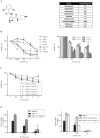


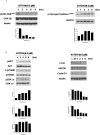
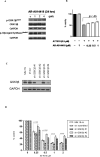
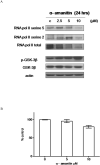
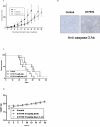
Similar articles
-
Biological characterization of AT7519, a small-molecule inhibitor of cyclin-dependent kinases, in human tumor cell lines.Mol Cancer Ther. 2009 Feb;8(2):324-32. doi: 10.1158/1535-7163.MCT-08-0890. Epub 2009 Jan 27. Mol Cancer Ther. 2009. PMID: 19174555
-
Inhibition of cyclin-dependent kinases by AT7519 is effective to overcome chemoresistance in colon and cervical cancer.Biochem Biophys Res Commun. 2019 Jun 4;513(3):589-593. doi: 10.1016/j.bbrc.2019.04.014. Epub 2019 Apr 10. Biochem Biophys Res Commun. 2019. PMID: 30979499
-
Inhibition of cyclin-dependent kinases by AT7519 enhances nasopharyngeal carcinoma cell response to chemotherapy.Cancer Chemother Pharmacol. 2020 May;85(5):949-957. doi: 10.1007/s00280-020-04068-2. Epub 2020 Apr 11. Cancer Chemother Pharmacol. 2020. PMID: 32279103
-
AT7519, a cyclin-dependent kinase inhibitor, exerts its effects by transcriptional inhibition in leukemia cell lines and patient samples.Mol Cancer Ther. 2010 Apr;9(4):920-8. doi: 10.1158/1535-7163.MCT-09-1071. Epub 2010 Mar 30. Mol Cancer Ther. 2010. PMID: 20354122
-
GSK-3beta regulates cyclin D1 expression: a new target for chemotherapy.Cell Signal. 2008 Apr;20(4):581-9. doi: 10.1016/j.cellsig.2007.10.018. Epub 2007 Oct 23. Cell Signal. 2008. PMID: 18023328 Review.
Cited by
-
Pim2 is important for regulating DNA damage response in multiple myeloma cells.Blood Cancer J. 2016 Aug 26;6(8):e462. doi: 10.1038/bcj.2016.73. Blood Cancer J. 2016. PMID: 27564460 Free PMC article.
-
Combination therapy targeting Erk1/2 and CDK4/6i in relapsed refractory multiple myeloma.Leukemia. 2022 Apr;36(4):1088-1101. doi: 10.1038/s41375-021-01475-z. Epub 2022 Jan 27. Leukemia. 2022. PMID: 35082402 Free PMC article.
-
GSK-3β inhibitor, 9-ING-41, reduces cell viability and halts proliferation of B-cell lymphoma cell lines as a single agent and in combination with novel agents.Oncotarget. 2017 Nov 11;8(70):114924-114934. doi: 10.18632/oncotarget.22414. eCollection 2017 Dec 29. Oncotarget. 2017. PMID: 29383130 Free PMC article.
-
Controlling the Mdm2-Mdmx-p53 Circuit.Pharmaceuticals (Basel). 2010 May 18;3(5):1576-1593. doi: 10.3390/ph3051576. Pharmaceuticals (Basel). 2010. PMID: 20651945 Free PMC article.
-
The mechanism of MYB transcriptional regulation by MLL-AF9 oncoprotein.Sci Rep. 2019 Dec 27;9(1):20084. doi: 10.1038/s41598-019-56426-7. Sci Rep. 2019. PMID: 31882723 Free PMC article.
References
-
- Bergsagel PL, Kuehl WM. Journal of Clinical Oncology. 2005;23:6333–6338. - PubMed
-
- Bhat R, Xue YF, Berg S, Hellberg S, Ormo M, Nilsson Y, Radesater AC, Jerning E, Markgren PO, Borgegard T, Nylof M, Gimenez-Cassina A, Hernandez F, Lucas JJ, Diaz-Nido J, Avila J. Journal of Biological Chemistry. 2003;278:45937–45945. - PubMed
-
- Cai DP, Latham VM, Zhang XX, Shapiro GI. Cancer Research. 2006;66:9270–9280. - PubMed
-
- Chauhan D, Kharbanda S, Ogata A, Urashima M, Teoh G, Robertson M, Kufe DW, Anderson KC. Blood. 1997;89:227–234. - PubMed
Publication types
MeSH terms
Substances
Grants and funding
LinkOut - more resources
Full Text Sources
Other Literature Sources
Medical
Miscellaneous

